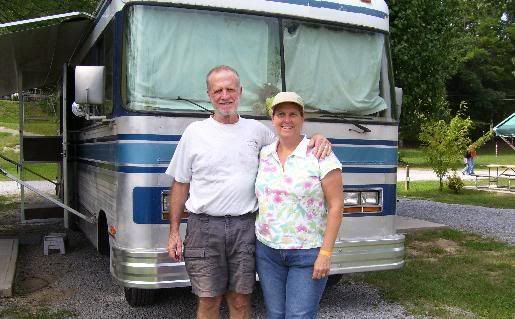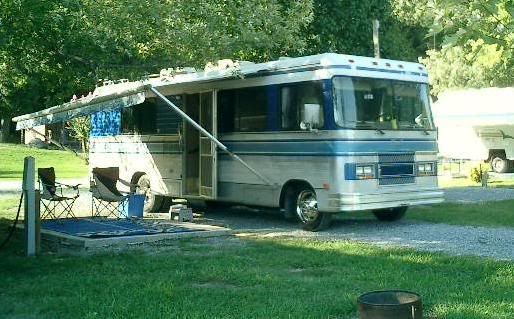Page 1 2
Go to...  | Start A New Topic  | Search  | Notify  | Tools  | Reply To This Topic  |  |
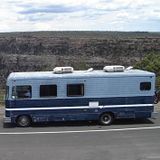 |
Hi, I decided to look at the ignition timing, and have purchased the Crane 99600-1 adjustable vacuum advance unit, and a Jegs advance weight and spring kit. 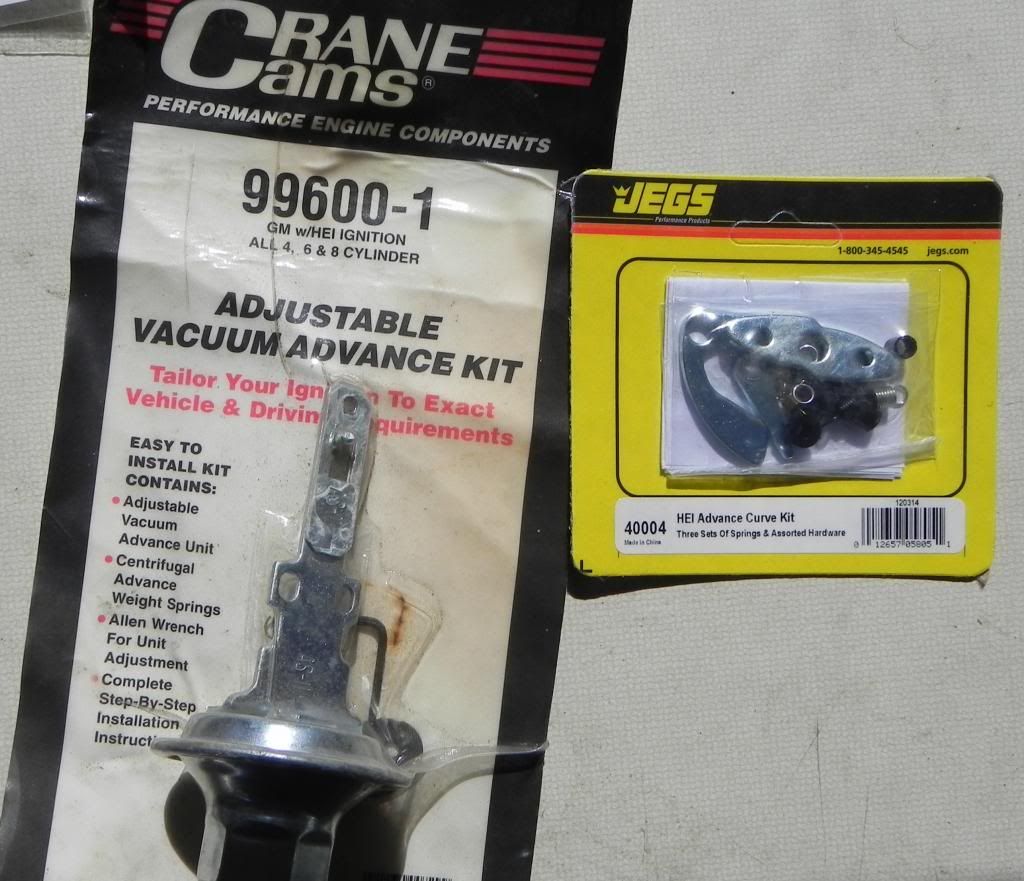 The exam of the distributor cap showed evidence inside of what someone else in this forum has called the "Red dust of failure". It is good to get rid of that possible fault. It looks like the springs in the HEI distributor are stock, and judging by the surface rust, they have been there since 1986. The tech writer for Crane could spend a bit more time understanding the product. Instructions include the phrase "remove old vacuum advance unit". Because of how the clearances between the advance shaft and the advance arm are, removal of the old advance unit can not be done by removal of screws. An internet search showed that the way to do this involves removing the distributor, removing the drive gear, removing the shaft, and then having clearance. It is really no big deal, but clear instructions are helpful. I started the "dial in" process. I put medium springs on, and was not happy with performance. Likewise with the lighter springs, though it seemed that performance was better. I advance the timing 2 degrees as the Crane instructions suggest, prior to the dial-in of the vacuum advance unit. I found the instructions from Crane hard to follow and found that others did to, and these other guys documented some steps. http://www.73-87.com/7387garage/drivetrain/hei.htm In the part "HEI Tips Addendum" a guy explains how to use the "advance lockout" to limit the amount of vacuum advance. I have put that unit in, and then retimed the distributor to be back to 6 degrees BTDC again. Things are getting better, I am able to accelerate up hills. I don't have any knocking or pinging that I hear, but steeper hills, when I floor it, the throttle response is weak. When I come up with "the recipe" for timing, I'll post it here. Happy Motoring, Matt 1987 Barth 27' P32 Chassis Former State Police Command Post Chevrolet 454 Weiand Manifold, Crane Cam, Gibson Exhaust | ||
|
 |
I should also point out that my temperature gauge is reading in the 180-200 range when flooring it on a flat interstate highway, instead of being on the 200-225 range. I am headed in the right direction. Also, it seemed that the old vacuum advance unit, that so much surface corrosion had occurred on the shaft, that it didn't want to move freely. Matt 1987 Barth 27' P32 Chassis Former State Police Command Post Chevrolet 454 Weiand Manifold, Crane Cam, Gibson Exhaust | |||
|
 3/11 3/11 |
Junk the old distributor and install an MSD ignition distributor and system. It is new technology and will not require any maintenance. 1993 32' Regency Wide Body, 4 speed Allison Trans, Front Entry door, Diamond Plate aluminum roof & 1981 Euro 22' w Chevy 350 engine and TH 400 tranny | |||
|
 |
I should have checked the vacuum lines first. I found 4 or 5 breaks of the lines. The ported vacuum port of the carb was connected to a vacuum delay valve, which was also connected to the manifold vacuum port of the carb, and on that vacuum delay valve, the third port was unconnected. The vacuum hoses were turning to powder, and cracking was everywhere. It looks like the distributor vacuum advance line had been replumbed to connect it to the ported vacuum port instead of the manifold vacuum of the carb, but because of a break elsewhere in that vacuum circuit, no vacuum signal was ever getting to my distributor. I got 6' of new line installed, basically in the stock configuration. There is no EFE valve on my engine due to the headers replacing the stock exhaust system. I changed the layout slightly so the distributor vacuum advance is directly connected to the H port of the carb, instead of to the H port via the delay valve. On my carb, the 800 CFM Quadrajet, 17085212, the H port is manifold vacuum, and the J port is ported vacuum. This seems to be the opposite of how many of the generic Quadrajet explanation videos on Youtube explain it. But on one of the videos, the mechanic said to test the port with your finger with the engine running at idle to see if a vacuum is there. If so, then that is the manifold vacuum port. He said that Rochester made different variations for different engine applications. Seems sensible in retrospect. Prior to checking this, my last test run was horrid. I had backfires through the carb, and backfires out the exhaust, depending on throttle position, hill pitch, and speed. I rechecked the plug wire assignments but all was well. Temperature was higher as well. I should probably check the plugs to make sure they are not getting fouled. To use a timing light on a 454 with the timing tab underneath the engine, put the inductive pickup on the #5 plug wire. I am guessing, but the lack of a vacuum signal might have been a contributing factor to the original vacuum can on the distributor having a problem with moving. I hope my next post here is more upbeat. Happy Motoring, Matt 1987 Barth 27' P32 Chassis Former State Police Command Post Chevrolet 454 Weiand Manifold, Crane Cam, Gibson Exhaust | |||
|
 8/11 8/11 |
After replacing my plugs, wires, and distributor I set my timing at idle with the vacuum to the distributor disconnected and plugged. Everything was great until I plugged my vacuum advance back in, the engine RPM would jump and the timing would go to full advance. I got to double checking my vacuum lines going to the carb and watched a video on YouTube to help verify that I was actually using the ported port on the carb. All the vacuum lines went to the correct port than I realized that my ported port was running full manifold vacuum and not the regulated vacuum which is no vacuum at idle. My carburetor was in need of a rebuild so I purchased a remanufactured carburetor from Summit Racing and that took care of my ported port issues, I have zero vacuum at idle and it climes as the throttle plate opens. I have perfect 700 rpm at idle and 10 degrees BTDC. Before all that my 454 would not run worth a hoot, backfire and hesitate on acceleration. Now she runs flawlessly, runs better than it ever has since I bought it. So for my Barth I had to use the ported port for vacuum advance to get it to run right. | |||
|
Official Barth Junkie |
Most of the traditional carb/distributor setups used ported vacuum for the vacuum advance, with no vacuum advance at idle (6-10 degrees BTDC), about 8-10 degrees full vacuum advance and about 22 degrees centrifugal advance by 3000 rpm. Later smog versions used the full time vacuum port, (retarded idle timing at about 0-4 degrees), with various valves to keep the vacuum advance from operating under most conditions. Usually a temperature valve allowing full advance only when fully warm, a delay valve, and often a transmission controlled valve allowing full advance only in top gear. Centrifugal advance did not max out until 4000 rpm, well above normal rpm range. Between that and the inevitable leaks in the many feet of vacuum lines, you had an engine which is chronically retarded and underpowered. Most will run better if they get more advanced timing. Direct route the vacuum line to the ported source, set idle timing at 8 degrees and keep advancing until it knocks under heavy load, then back off 2 degrees. With my stock distributor I ended up at 12 degrees BTDC (which is what Thorley recommended with their headers, too.) The stock distributor had only 5 degrees vacuum advance, with full centrifugal advance at 4000 rpm. The Summit replacement had 10 degrees vac advance and centrifugal advance maxed at 3000 rpm. I kept the idle timing at 12 degrees. Ran well. Good luck with your tuning, keep us posted. (If you want it to REALLY run well, try fuel injection!) 9708-M0037-37MM-01 "98" Monarch 37 Spartan MM, 6 spd Allison Cummins 8.3 325+ hp | |||
|
 |
I just wanted to say that my efforts are a work in progress.... Right now I have the manifold vacuum in use. I have the timing at 12 degrees also. I have the lightest set of springs in use. I am going to "play" with the Crane adjustable vacuum advance unit. In the 2000 to 3000 RPM range, the engine provides a good "seat of the pants" feel for improved power. Starting with 12 degrees advance, and the vacuum line in place makes for hard starting. For my testing today, I took the vacuum line off the distributor to start the engine. While in park, the engine spins easily up to 5000 RPM. Under load, the engine seems to bog down at 3500 RPM. I don't know if it is the timing or if the carb is troubled. In my tests, I haven't heard any knocking or pinging. I've hooked up a vacuum gauge to help me understand what is going on. At idle I get about 20" of vacuum. When I get under 5" of vacuum when driving near 3000 RPM I get the feeling that the engine doesn't want to run faster, so that might be a timing issue. I've been taking some short drives with the engine cover off, and the added visual cues seem helpful. I wouldn't do this, running with no air cleaner in place if I lived in a dusty area. I can see when the secondaries open up, and I think I need to better work the ignition timing for that added air flow. In thinking about the timing problems I had, I feel confident in thinking that the vacuum delay valve and the thermal vacuum switch have probably stopped functioning in my rig, and that was slowing my progress. Also slowing my progress: I think I set ignition timing once during the fast idle at 1200 RPM instead of 800 RPM. With the light springs, that turns out to be 4 degrees of timing. I also had assumed that the springs, no matter what size, had no effect at 800 RPM. But each spring change requires work with the timing light to validate the initial timing. It looks like the engine is running 10-20 degrees cooler. I am having fun with this and have more work to do. This has helped my understanding: http://www.73-87.com/7387garage/drivetrain/hei.htm Happy Motoring! Matt 1987 Barth 27' P32 Chassis Former State Police Command Post Chevrolet 454 Weiand Manifold, Crane Cam, Gibson Exhaust | |||
|
 |
I had some timing setups where the engine ran poorly, but was easy to start. But during different running conditions, I'd have misfires through the carb and later backfires out the exhaust. I really felt I was going backwards in my efforts... Matt 1987 Barth 27' P32 Chassis Former State Police Command Post Chevrolet 454 Weiand Manifold, Crane Cam, Gibson Exhaust | |||
|
| First Month Member |
Driving with an air cleaner removed can be dangerous if there is a backfire. I use an old marine spark arrestor for fire safety when driving with the air cleaner removed. At the minimum, wear eye protection and have a passenger with an extinguisher. . 84 30T PeeThirty-Something, 502 powered | |||
|
 |
I want to thank Bill H for the safety tip. I won't do that again. I wanted to report that at one point when starting the rig, with the air cleaner off, the flame plume from the carb was very impressive, and had any loose paper been nearby, results could have been tragic. But the benefit of the drive I did with the air cleaner off was this: I saw that the secondaries were never opening. At risk of a thread drift, I found the following: - the choke assembly is electric and has an arm which prevents the secondary throttle shaft from opening - it is intended that this be adjusted so after warm up, the secondaries can open - the electric choke had a wire directly spliced to the alternator - the air flow through the secondaries is gated by the "air doors" of the carburetor - after adjusting the choke such that the secondary throttle could turn, it still seems that the secondary air doors were not allowing air flow (I'd been warned by Bill H and I'd seen a flame plume so I drove with the air cleaner on, so I don't have visual confirmation of this) - the spring tension in the secondary air doors can be adjusted, but I don't yet have the right torx driver to allow for this. On youtube, "whosaidtyler" has some good overview descriptions of "how to debog your quadrajet". Oh, by the way, the wire between the choke and the distributor had a gash in it exposing the conductor. I don't want to guess what problems this could cause down the road.... Matt 1987 Barth 27' P32 Chassis Former State Police Command Post Chevrolet 454 Weiand Manifold, Crane Cam, Gibson Exhaust | |||
|
| First Month Member |
You're welcome. It is good to know that I am not a Nervous Nelly. GM put a mesh spark arrestor in the air cleaner. I know of one Barth owner whose Barth burned up because the spark arrestor had been removed and something went wrong while his kid was driving it. Fire apparently belched out the air cleaner snout and set fire to the plywood. Perhaps a little sheet metal and some asbestos would be a good idea. I am glad my intake is routed to cold air so I don't flame my engine compartment. I have seen so many things go wrong that I worry about all my cautions seeming excessive. . 84 30T PeeThirty-Something, 502 powered | |||
|
 6/12 6/12Formally known as "Humbojb" 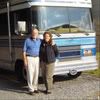 |
Bill, you're not a 'nn'. You're just smart. J
| ||||||||||||
|
 |
Such a great file, Barthmobile! I'd been messing with the ignition, and playing with the carburetor, and not getting the results I want. I'd found problems with the choke wiring, and found that the vacuum lines were on the verge of disintegrating. Yet with all the fixes, the results were not forthcoming to the extent I'd desired. So, sometimes a guy has to say, "What would Bill-NY and Bill H tell me to do." And I replaced the fuel filters, even though they have less than 15K miles on them. Taking out the filter on the frame, on the input side, it looked like rusty water spilling out. To borrow a phrase, "ba da bing"! Big difference in performance. Time to revisit the carb and timing issues now, again. happy motoring! Matt 1987 Barth 27' P32 Chassis Former State Police Command Post Chevrolet 454 Weiand Manifold, Crane Cam, Gibson Exhaust | |||
|
Official Barth Junkie |
This is why I still consider my fuel pressure gauge one of the most important, especially now with the fuel injection system. I have had numerous fuel related starvation issues which might have been mis diagnosed without fuel pressure info. Lots of crap gas out there now days. 9708-M0037-37MM-01 "98" Monarch 37 Spartan MM, 6 spd Allison Cummins 8.3 325+ hp | |||
|
 3/23 3/23 |
One other gauge on my cruiser's helm is a manifold vac for each engine. More info, more knowledge less confusion. On long hills with low vac and good pressure you have good pump and filters. Gas of course, diesel is a bit different. | |||
|
| Powered by Social Strata | Page 1 2 |
| Please Wait. Your request is being processed... |
|
This website is dedicated to the Barth Custom Coach, their owners and those who admire this American made, quality crafted, motor coach.
We are committed to the history, preservation and restoration of the Barth Custom Coach.
We are committed to the history, preservation and restoration of the Barth Custom Coach.
